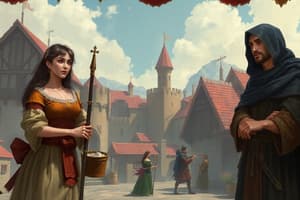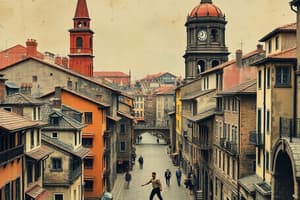Podcast
Questions and Answers
The period after the decline of the Roman Empire is commonly referred to as the 'dark ages'.
The period after the decline of the Roman Empire is commonly referred to as the 'dark ages'.
True (A)
What economic system continued in Western Europe during the post-Roman era?
What economic system continued in Western Europe during the post-Roman era?
Feudalism
Which cities in Northern Italy emerged as important trading cities?
Which cities in Northern Italy emerged as important trading cities?
- Milan
- Florence
- Venice
- All of the above (correct)
What was the estimated population of Venice in 1363?
What was the estimated population of Venice in 1363?
The word ______ was applied to a Jewish neighborhood in Venice.
The word ______ was applied to a Jewish neighborhood in Venice.
What percentage of a medieval city's budget was spent on wall maintenance?
What percentage of a medieval city's budget was spent on wall maintenance?
The industrial revolution led to a greater reliance on rural populations.
The industrial revolution led to a greater reliance on rural populations.
What were the two main types of capitalism that emerged during medieval times?
What were the two main types of capitalism that emerged during medieval times?
Which of the following was a significant factor in the onset of the industrial revolution?
Which of the following was a significant factor in the onset of the industrial revolution?
What was the urbanization percentage of England by 1890?
What was the urbanization percentage of England by 1890?
Which type of transportation fueled the industrial revolution and provided raw materials?
Which type of transportation fueled the industrial revolution and provided raw materials?
Flashcards are hidden until you start studying
Study Notes
The Decline of Cities and the “Dark Ages”
- Following the fall of the Roman Empire (476 AD), Europe experienced a period of stagnation and decline of large cities.
- The period between 476 AD and 1000 AD is referred to as the “dark ages”.
- The economic system shifted to feudalism, characterized by self-sufficient estates called autarky, where peasants worked the land for the local lord or bishop.
- Trade was minimal during this era.
Medieval Urban Renaissance and Early Capitalism
- The 5th to 15th centuries saw a revival of urbanisation with the growth of trade and early forms of capitalism.
- Cities in Northern Italy, like Milan, Florence, and Venice, emerged as significant trading centers, connecting to the far east.
- Venice, in 1363, had a population of approximately 80,000 people.
- These cities were often considered city-states, highlighting the importance of “citizenship” and independence.
- The merchant class, with their movable assets, rose to power, shifting the societal order from Feudalism.
- Guilds, occupational groupings, were formed to solidify the merchants' political organization and power.
Spatial Organization of Medieval Cities
- The medieval city's spatial form was compact, characterized by walls for protection and a central market square.
- Market squares were essential for trade, with major cities having multiple locations.
- Harbours and canal systems facilitated trade, while winding streets patterns defined the urban spaces.
- The social geography of medieval cities was complex and often based on occupation and ethnic identities.
- Segmented neighborhoods, including the "ghetto" in Venice, were reserved for specific groups, including Jewish communities.
Growth of Kingdoms and the Rise of Capitalism
- The consolidation of kingdoms led to the end of independent trading cities.
- However, capitalism was integrated into the economies of European kingdoms and states.
- Despite urban growth, the majority of the population remained rural, with a small percentage living in cities.
The Industrial Revolution and Its Impact on Urbanization
- The industrial revolution, during the 18th and 19th centuries, dramatically reshaped cities.
- A shift to an economy focused on production and exchange demanded a larger workforce.
- Innovations in power supply, particularly the coal-burning steam engine, fueled the industrial revolution.
- The factory system centralized hundreds of workers and enabled mass production.
- Improvements in agriculture reduced the need for farm labor and sparked a movement of surplus workers to urban factories.
- England became the epicenter of the industrial revolution in the 18th century, later spreading to other parts of Europe and the world.
The Impact of Global Trade, Colonialism, and Urban Growth
- Global trade, the slave trade, and colonialism fueled the industrial revolution.
- Colonies provided raw materials needed for industrial production.
- The industrial revolution accelerated urbanization on a massive scale.
- Europe’s population doubled throughout the 1800s and its urban population increased sixfold.
- England's urbanization rates climbed from 20% in 1800 to 40% in 1850 and 60% in 1890.
- London's population soared from 1 million in 1800 to 2.5 million in 1850 and 6.5 million by 1900.
Studying That Suits You
Use AI to generate personalized quizzes and flashcards to suit your learning preferences.




